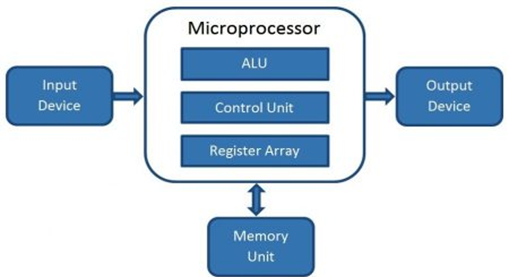SKYSPIN
A digital computer with one microprocessor which acts as a CPU is called microcomputer.
It is a programmable, multipurpose, clock -driven, register-based electronic device that reads binary instructions from a storage device called memory, accepts binary data as input and processes data according to those instructions and provides results as output.
The microprocessor contains millions of tiny components like transistors, registers, and diodes that work together.
 A microprocessor consists of an ALU, control unit and register array. Where ALU
performs arithmetic and logical operations on the data received from an
input device or memory. Control unit controls the instructions and flow
of data within the computer. And, register array consists of registers identified by letters like B, C, D, E, H, L, and accumulator.
A microprocessor consists of an ALU, control unit and register array. Where ALU
performs arithmetic and logical operations on the data received from an
input device or memory. Control unit controls the instructions and flow
of data within the computer. And, register array consists of registers identified by letters like B, C, D, E, H, L, and accumulator.
It was a processor on a single chip. It could perform simple arithmetic and logical operations such as addition, subtraction, Boolean OR and Boolean AND.
I had a control unit capable of performing control functions like fetching an instruction from storage memory, decoding it, and then generating control pulses to execute it.
Other improved 64-bit processors are Celeron, Dual, Quad, Octa Core processors.
What is a Microprocessor?
Computer's Central Processing Unit (CPU) built on a single Integrated Circuit (IC) is called a microprocessor.A digital computer with one microprocessor which acts as a CPU is called microcomputer.
It is a programmable, multipurpose, clock -driven, register-based electronic device that reads binary instructions from a storage device called memory, accepts binary data as input and processes data according to those instructions and provides results as output.
The microprocessor contains millions of tiny components like transistors, registers, and diodes that work together.
Block Diagram of a Microcomputer
 A microprocessor consists of an ALU, control unit and register array. Where ALU
performs arithmetic and logical operations on the data received from an
input device or memory. Control unit controls the instructions and flow
of data within the computer. And, register array consists of registers identified by letters like B, C, D, E, H, L, and accumulator.
A microprocessor consists of an ALU, control unit and register array. Where ALU
performs arithmetic and logical operations on the data received from an
input device or memory. Control unit controls the instructions and flow
of data within the computer. And, register array consists of registers identified by letters like B, C, D, E, H, L, and accumulator.Evolution of Microprocessors
We can categorize the microprocessor according to the generations or according to the size of the microprocessor:First Generation (4 - bit Microprocessors)
The first generation microprocessors were introduced in the year 1971-1972 by Intel Corporation. It was named Intel 4004 since it was a 4-bit processor.It was a processor on a single chip. It could perform simple arithmetic and logical operations such as addition, subtraction, Boolean OR and Boolean AND.
I had a control unit capable of performing control functions like fetching an instruction from storage memory, decoding it, and then generating control pulses to execute it.
Second Generation (8 - bit Microprocessor)
The second generation microprocessors were introduced in 1973 again by Intel. It was a first 8 - bit microprocessor which could perform arithmetic and logic operations on 8-bit words. It was Intel 8008, and another improved version was Intel 8088.Third Generation (16 - bit Microprocessor)
The third generation microprocessors, introduced in 1978 were represented by Intel's 8086, Zilog Z800 and 80286, which were 16 - bit processors with a performance like minicomputers.Fourth Generation (32 - bit Microprocessors)
Several different companies introduced the 32-bit microprocessors, but the most popular one is the Intel 80386.Fifth Generation (64 - bit Microprocessors)
From 1995 to now we are in the fifth generation. After 80856, Intel came out with a new processor namely Pentium processor followed by Pentium Pro CPU, which allows multiple CPUs in a single system to achieve multiprocessing.Other improved 64-bit processors are Celeron, Dual, Quad, Octa Core processors.



0 Comments